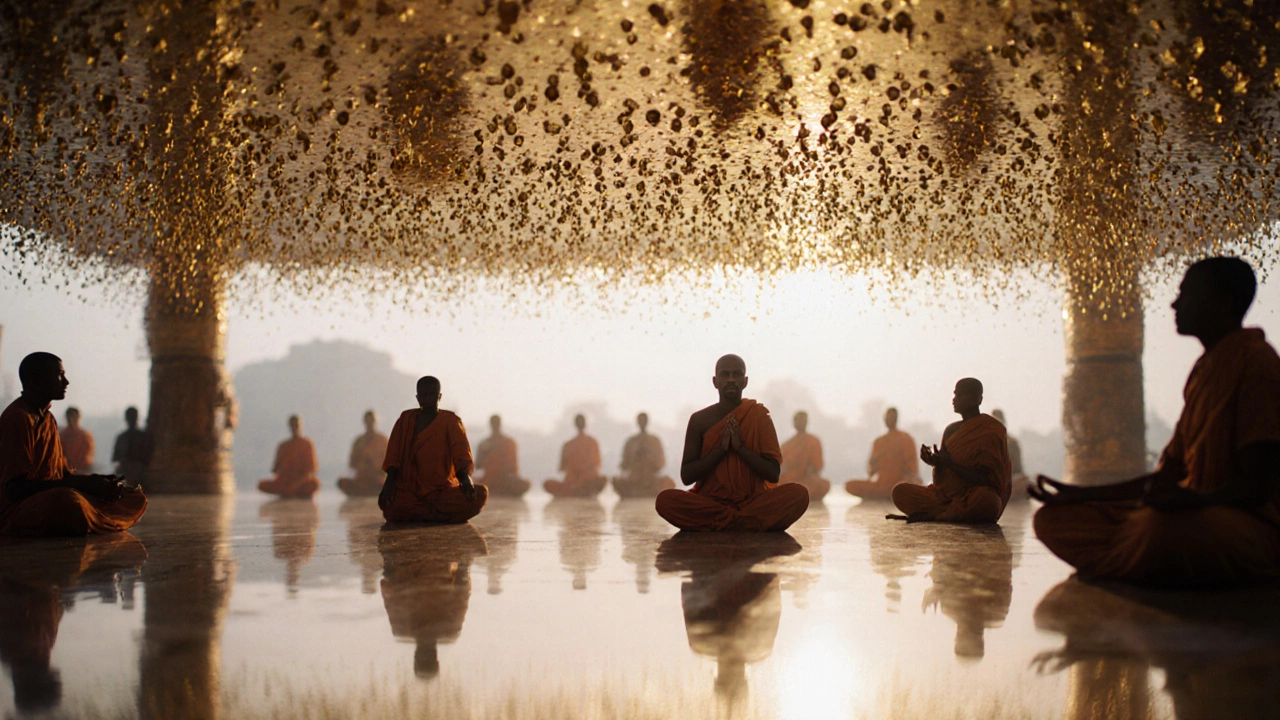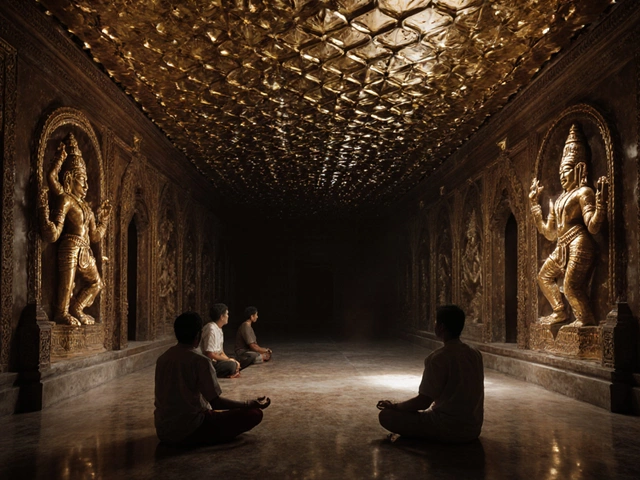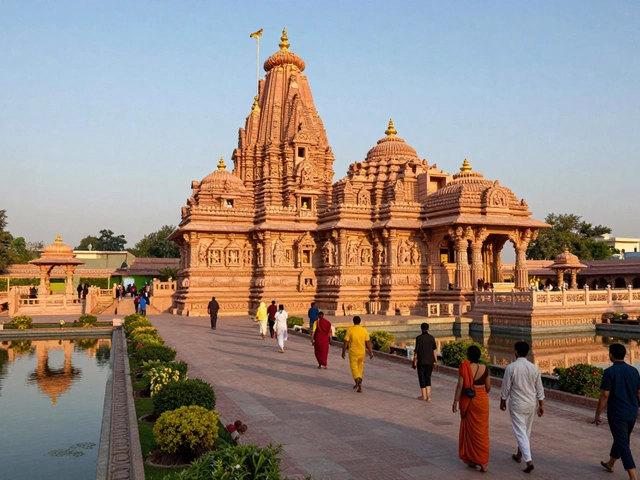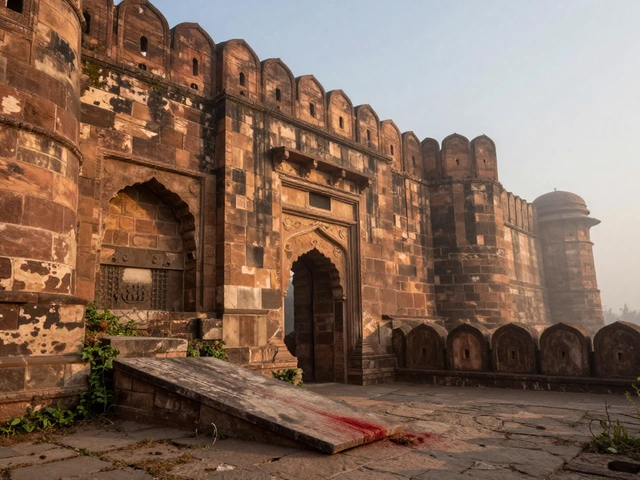There’s only one temple in India where the main deity isn’t inside a sanctum at all. Not because it’s abandoned, not because it’s hidden - but because the god is the space itself. This isn’t metaphor. It’s architecture, theology, and ancient science fused into one impossible structure. If you’ve ever visited a Hindu temple expecting statues, incense, and bells, you’re not ready for Chidambaram’s Nataraja Temple.
The Temple That Has No Idol
Most temples have an idol. A murti. A carved stone or metal form of a god you can touch, offer flowers to, or stare into during prayer. But in Chidambaram, Tamil Nadu, the central shrine holds nothing. No statue. No image. No ornament. Just an empty space, covered by a golden roof, called the Chit Sabha - the Hall of Consciousness. This isn’t a design flaw. It’s the entire point. The deity here is Lord Nataraja, the cosmic dancer - but not as a sculpture. Here, he’s represented by the akasha lingam, the formless element of space. The five elements of Hindu cosmology - earth, water, fire, air - each have their own lingam in other temples. But space? Only here. Only in Chidambaram. Visitors often walk in confused. They look around. They ask, "Where is the god?" The answer isn’t found in the architecture. It’s found in the silence. The stillness. The absence.Why This Temple Is Unique
India has over two million temples. Some are ancient. Some are massive. Some are built into mountains. But none are like this. The Nataraja Temple is the only one in the country where the primary deity is not visible - and that’s by design. This isn’t just a philosophical oddity. It’s rooted in the ancient Shaiva Agamas, the sacred texts that guide temple construction. These texts say that the ultimate form of Shiva is beyond shape. To represent him as a statue would be to limit him. So here, they built a temple to the formless. The golden roof over the empty space is made of 21,600 gold plates - one for each breath a human takes in a day. 72,000 nadis, or energy channels, are symbolized by the temple’s intricate carvings. The whole structure is a living diagram of the human body and the cosmos. You won’t find this anywhere else in India. Not in Kashi. Not in Somnath. Not in Tirupati. Not even in the great Shiva temples of Madurai or Rameswaram. Only here.The Dance That Holds the Universe
The temple’s name - Nataraja - means "King of Dance." The cosmic dance of Shiva isn’t just art here. It’s physics. It’s the rhythm of creation and destruction. The dance isn’t performed by a statue. It’s performed by the universe, and this temple is the stage. The four arms of Nataraja are carved into the walls surrounding the Chit Sabha. One hand holds fire - destruction. Another holds a drum - creation. The third is raised in blessing. The fourth crushes the demon of ignorance. But the center? Empty. Because the dance isn’t something you watch. It’s something you feel. Priests don’t worship an idol. They chant mantras into the empty space. Devotees meditate before it. Scientists who’ve studied the temple say the acoustics are designed to resonate at the same frequency as the human brain’s alpha waves. It’s not superstition. It’s intention.
Who Built It? And Why?
The temple’s origins stretch back over 1,400 years. The Chola dynasty - rulers of South India from the 9th to 13th centuries - expanded it into the structure you see today. But the core idea? Older. Much older. Legend says the temple was built where Shiva danced after defeating the sages of the Darukavana forest. They had mocked him, claiming his formless nature was meaningless. So he danced - and revealed that the universe itself was his body. The Cholas didn’t invent this concept. They perfected it. They hired the best architects, sculptors, and astronomers. They aligned the temple’s main axis with the star Sirius. They built the sanctum so that on certain days, sunlight hits the empty space exactly at noon - a daily reminder that the divine isn’t confined to stone.What You’ll See When You Visit
If you go to Chidambaram, don’t expect a towering statue. Don’t expect crowds pushing to touch a relic. You’ll see:- A simple, rectangular shrine with a golden roof - no doors, no locks, no barriers.
- Walls covered in 108 dance poses of Nataraja - each carved with impossible precision.
- A courtyard with a sacred tank, where pilgrims bathe before entering.
- Monks chanting Vedic hymns in rhythmic waves that echo through the halls.
- Devotees sitting silently, eyes closed, hands resting on their knees - not praying to a god, but listening to the silence.

Why This Temple Still Matters Today
In a world obsessed with visible things - influencers, gadgets, viral trends - Chidambaram offers a radical alternative. The divine doesn’t need a face. It doesn’t need to be posted online. It doesn’t need to be photographed. This temple asks you to look inward. To question what you think you know about worship. About presence. About reality. Modern neuroscientists and quantum physicists are now studying the temple’s design. Some believe the acoustics and geometry were intentionally crafted to induce meditative states. Others say the alignment with celestial bodies points to an ancient understanding of cosmic energy. Whatever you believe, one thing is clear: this temple doesn’t just exist. It challenges you.How to Visit Chidambaram
Chidambaram is in Tamil Nadu, about 240 kilometers from Chennai. The nearest airport is Chennai International. From there, take a train or hire a car - the journey takes about five hours. Best time to visit: October to March. The weather is cooler, and the temple hosts major festivals during Shivaratri and the Margazhi month (December-January). Dress code: Modest clothing. Men wear dhotis or trousers; women wear sarees or salwar kameez. Shoes must be left outside. Photography is allowed in the outer courtyards, but not inside the Chit Sabha. Don’t rush. Sit for 15 minutes in front of the empty shrine. Breathe. Listen. Ask yourself: What does it mean to worship something you can’t see?Other Temples That Come Close - But Still Fall Short
Some will tell you about the Somnath Temple. Or the Kedarnath. Or the Tirumala Venkateswara Temple. All are ancient. All are sacred. But none are like Chidambaram. In Somnath, the lingam is made of stone. In Kedarnath, it’s a natural ice formation. In Tirumala, the idol is gold-plated and adorned with jewels. All are visible. All are touchable. All are representational. Chidambaram is the only temple where the god is defined by what’s not there. It’s not a temple with a hidden idol. It’s a temple that says: the divine is not hidden. It’s everywhere. And sometimes, you have to stop looking to see it.Is the Chidambaram Temple the only temple in India with no idol?
Yes. While India has thousands of temples with idols, the main sanctum of the Nataraja Temple in Chidambaram contains no statue or physical representation of Lord Shiva. Instead, the deity is symbolized by an empty space under a golden roof, known as the akasha lingam - representing the formless, all-pervading nature of consciousness. No other temple in India follows this exact theological design.
Why is the Chidambaram Temple called the "Space Temple"?
It’s called the "Space Temple" because its central deity, Nataraja, is represented by the element of space (akasha), one of the five fundamental elements in Hindu cosmology. While other temples honor earth, water, fire, or air through physical lingams, Chidambaram is the only one dedicated to space - the infinite, invisible, all-encompassing medium in which everything exists. The golden roof over the empty sanctum symbolizes the sky, and the entire structure is designed to reflect the universe’s structure within the human body.
Can you take photos inside the Chit Sabha?
No. Photography is strictly prohibited inside the Chit Sabha, the inner sanctum with the empty space. This rule is not about secrecy - it’s about reverence. The sanctum is meant for silent meditation, not visual documentation. Visitors are welcome to photograph the outer courtyards, the dance carvings, and the temple gates, but the central shrine remains a space for inner experience, not external capture.
Is Chidambaram Temple open to all visitors?
Yes. The temple welcomes people of all faiths, backgrounds, and nationalities. There are no restrictions based on religion or caste. Visitors must follow the dress code and remove their shoes before entering the inner areas. The temple’s philosophy is rooted in the idea that the divine is accessible to anyone who seeks it with sincerity - regardless of how they pray or what they believe.
What makes the acoustics of Chidambaram Temple special?
The temple’s architecture was designed to amplify and focus sound in a way that enhances meditation. The dome-shaped ceiling and stone walls reflect chants and mantras in a precise, resonant pattern. Studies suggest the acoustics align with the natural frequency of human brainwaves during deep meditation. Even a whisper near the sanctum can be heard clearly across the hall - a feature likely intentional to help devotees feel the presence of sound as a form of the divine.
If you’ve ever wondered what spirituality looks like without images, without rituals, without symbols - Chidambaram shows you. It doesn’t ask you to believe. It asks you to be still. And in that stillness, you might just find what you’ve been looking for all along.






